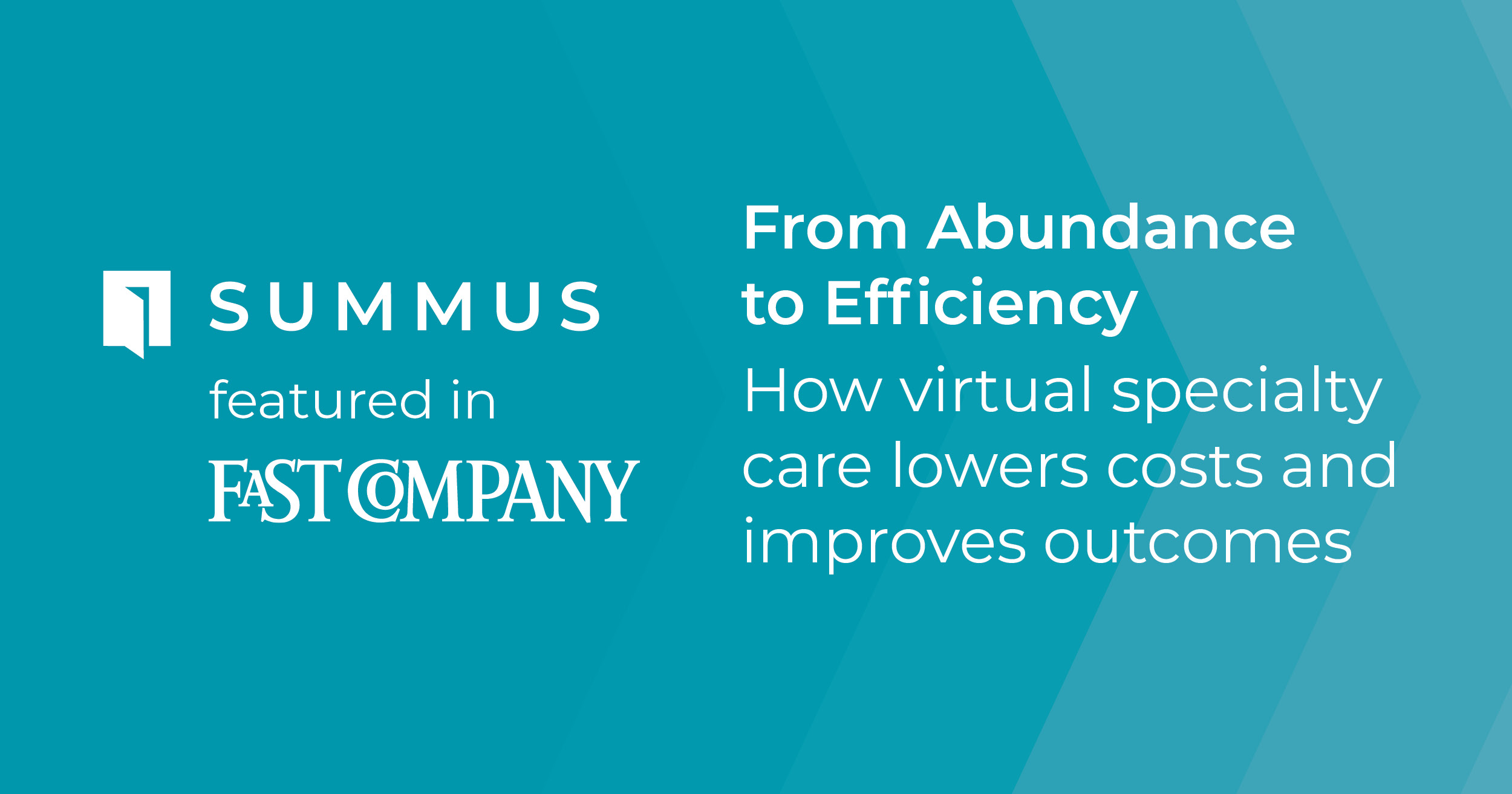Fast Company Executive Board member Julian Flannery of Summus Global explains that costs “live” in specialty care—but a robust virtual care platform can help drive them down while elevating outcomes.
In healthcare, the majority of cost and complexity lives in specialty care, says Julian Flannery, founder and CEO of Summus, a leading virtual specialty care company. Whereas a primary care clinic is the “medical home” for most patients and their families, where they go for routine checkups, physicals, or acute but non-serious concerns that resolve in one to two visits (ear infections, conjunctivitis, stomach viruses), specialty care refers to really everything else outside of what patients receive from their PCP. This ranges from missed developmental milestones, migraines and chronic conditions such as diabetes or high blood pressure, to serious and complex diseases such as ALS or cancer.
The complexity of specialty care inherently requires more resources—and more money. For patients facing serious health concerns, costs can become exorbitant, and the cost goes beyond a single bill from the hospital or specialist. “Health journeys in specialty care are rarely isolated to a point in time or a single doctor visit. There is the complexity of what tests to get, what a diagnosis means, decisions on a treatment path or surgery, and all of the associated elements of a journey including nutrition, mental health, rehabilitation, drug regimens—all of which is costly and complicated. Additionally, personal travel expenses and time can add up for families,” Flannery says.
Healthcare costs are not solely monetary, either. In many parts of the country, particularly in rural communities, patients face access problems due to the limited availability of specialty care; as a result, they may wait weeks or even months to see a specialist. “When a patient is struggling and waiting to see a specialist or get treatment, it is extremely stressful which presents mental health challenges, and can also lead them to get sicker,” Flannery says.
A NEED FOR LONGITUDINAL SOLUTIONS
Flannery says that today’s solutions aren’t meeting the needs of patients and families because either they are designed to be point-in-time solutions, like a second opinion, or they are too narrow in focus within a disease category. He maintains that the answer is often more complex, and requires looking at the entirety of their medical journey and supporting multiple dimensions of a condition or disease. Moreover, a patient may be seeing multiple practitioners who do not see the whole picture, which can result in extra visits, lack of integrated care, and other redundancies that add costs and risk to a patient journey.
Today, there is an over-reliance on multiple condition-specific solutions. Flannery stresses that there are companies doing great work within disease categories (such as diabetes and fertility), but often, the result for the patient is a lack of integrated care, where they must make multiple stops to receive a treatment plan for each individual issue in a tapestry of intertwined health concerns. For the employer providing health benefits and the employee (or patient), this abundance of solutions drives up costs and creates confusion. “From a cost perspective, data show that a small percentage of total employees drive north of 80% of costs on average for employers, and the majority of those cases are complex and require a longitudinal perspective,” Flannery says. “Solutions must account for this—from an access and breadth perspective.”
LEVERAGING THE VALUE OF HIGH-QUALITY EXPERTISE
For Flannery and the Summus team, answers to the systemic issues of access to specialty care are clear: patients must be able to access the right specialists easily and quickly across all health questions. These specialists, in turn, must be able to view and engage with a patient and their family across their entire journey.
Summus has built a platform that connects specialists with peer clinicians and with patients at key inflection points on a health journey, across the continuum of care. “It’s about getting people accelerated access to high-quality medical expertise, to help them understand what path they need to be on and how to think about the decisions they need to make along the journey,” Flannery says.
In today’s healthcare system, the value of high-quality expertise is often overshadowed by the costs of tests, procedures and treatments that dominate the cost equation for payers and self-funded employers. Flannery explains that if employees receive faster access to expertise that is curated to their question or condition, they are going to make much better decisions about their care, which drives material cost avoidance, versus jumping into the world of specialty care without knowing how to navigate or make good decisions.
Avoided visits, tests, ER trips, surgeries, and optimized treatment paths are all possible with fast access to high-quality clinical expertise. “The concept of expertise is so undervalued in the market, and yet it has such an incredible impact in terms of orienting patients to the right types of journeys and the right types of procedures—as well as avoiding the time and cost associated with the wrong ones,” says Flannery.
SAVINGS OFFERED BY A STREAMLINED APPROACH
In seeking to mitigate costs associated with specialty care, particularly in complex cases, Flannery stresses the need to look at the problem as going “from abundance to efficiency,” particularly for companies looking for healthcare options that deliver a strong and demonstrable ROI. Today, many companies offer healthcare benefits that overlap with each other or simply aren’t being used by employees for a variety of reasons. When combined with strong primary care offerings, Summus’ virtual specialty care platform serves as a clinical front door to high-quality specialized care—both virtually and in person—and helps companies drive efficiency and employee utilization by offering one clinical entry point for all specialized conditions. By streamlining the approach to specialty care across the spectrum of conditions, companies are able to significantly drive down costs.
Importantly, Summus has created a methodology to measure impact and ROI using an episodic cost savings model to show the effect on a health journey. “We measure impact against a cohort that is geographically and demographically the same, within the most common journeys,” Flannery explains. By looking at these data, Summus is able to “calculate cost avoidance reliably within that episode of care and deliver an honest assessment of impact.” This method gives employers a clearer view of how Summus has impacted their population, versus trend analysis, which can be obfuscated by multiple factors over time and is often backward-looking.
THE TRUE BOTTOM LINE
While the matrix of cost, complexity, and care remains one of the critical challenges of healthcare today, not to mention a primary concern for HR and benefits leaders, the Summus team is resolutely focused on employee outcomes and experiences as KPIs. “We provide employees access to the most trusted and critical part of healthcare—the doctor,” says Flannery. And employees are appreciative; a recent outcomes report from Summus’ partnership with a major research university noted that the university’s HR department “actually gets proactive emails from their employees on a weekly basis saying how grateful they are for this solution.”
Flannery finds successes like these affirming, but not surprising. Given the incredible stress that patients face trying to navigate the healthcare system and make the best decisions for themselves, all while juggling issues of cost, access, and delays in care, it’s only natural that providing a “front door” would eliminate a lot of stressors, and result in far better healthcare experiences. “The first step is to connect that patient with a high-caliber doctor who will help them understand what they need to do,” he says. “That in itself is really powerful.”






